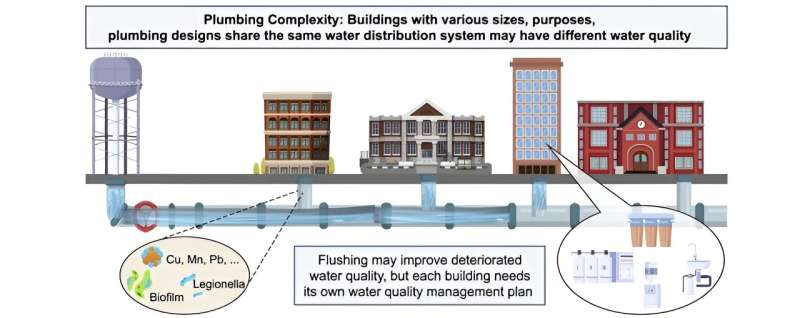This article has been reviewed according to Science X's editorial process and policies. Editors have highlighted the following attributes while ensuring the content's credibility:
fact-checked
trusted source
proofread
Pandemic lockdowns and water quality: A revealing study on building usage

In a recent study published in the journal Environmental Science and Ecotechnology, reveals crucial insights into the impact of reduced building occupancy on water quality.
Conducted at Purdue University, this research explored the impact of reduced building occupancy during the COVID-19 pandemic on water quality. The study focused on four buildings with varied characteristics and assessed water quality changes during low-use periods. Monitoring key parameters such as heavy metal concentrations and chlorine levels, it evaluated the effects of water stagnation.
The findings showed that prolonged stagnation led to significant variations in water quality, including changes in heavy metal and chlorine levels. These variations were influenced by factors like the building's age, size, and water system design. The study also assessed the effectiveness of flushing practices, a method to refresh stagnant water in plumbing systems.
The results revealed that while flushing could alleviate some of the negative effects of stagnation, its effectiveness varied across different building types, highlighting the complexity of managing water quality in buildings with changing occupancy levels. This research underscores the importance of developing customized water management strategies, particularly during unexpected events like pandemics, which can significantly alter building usage patterns.
Lead researcher Kyungyeon Ra, along with a team from Purdue University, underscores the significance of this research in understanding the changes in water quality due to altered building occupancy patterns during the pandemic.
This study highlights the need for effective water management strategies in buildings with low occupancy. The findings have implications for public health, particularly in understanding and mitigating risks associated with water stagnation and devising appropriate flushing protocols.
More information: Kyungyeon Ra et al, Four buildings and a flush: Lessons from degraded water quality and recommendations on building water management, Environmental Science and Ecotechnology (2023). DOI: 10.1016/j.ese.2023.100314
Provided by Chinese Academy of Sciences




















